‘I lost my eye’: The price of protesting US police brutality
Demonstrators in five cities describe how police used force on peaceful protests, resulting in serious injuries, trauma.
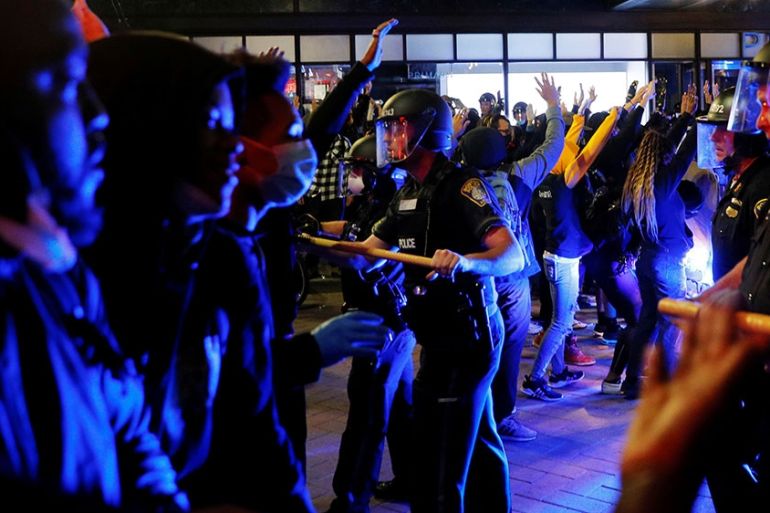
Anthony Evans says his hands were in the air: “You know, to show that I wasn’t a threat.” The young Black man, who had just turned 26 years old, had been protesting outside the police department headquarters in Austin, Texas, on May 31, when he was separated from his twin brother. The evening had passed relatively peacefully until that moment, Evans said, but as he walked back to try to find his twin, he noticed the tension escalating between police and protesters.
“As I put my hands in the air and started to jog, I got shot in the face, and then, I went down to my knees,” he told Al Jazeera. He could not be entirely sure what hit him at the time: a rubber bullet or beanbag round. But it had been fired by police, he said. Acting on impulse, he first moved to shield a nearby woman from the incoming fire, but then, she noticed that he was the one bleeding and went to get help.
Keep reading
list of 4 itemsFormer US police officer sentenced in killing of Black man Elijah McClain
US paramedics found guilty in 2019 death of Black man Elijah McClain
Angela Davis: ‘Palestine is a moral litmus test for the world’
After getting brief attention at a civilian care station, Evans said he walked off in the direction of his home with blood running down his swollen face. “My phone was dead, I was by myself, I had no friends or family with me, so at that point, I was like, ‘I just got to get home, I got to get to somewhere safe.'” He tried to flag down a passing car whose driver, he said, looked confused, shook his head and drove off. Then, he found a police officer. “I cautiously put my hands in the air and started walking towards the officer,” he recalled. According to Evans, the officer told him he could not help because he had to go “shut down the highway”.
“He just drove off without hearing my side of what happened,” Evans explained. That left the Austin native with only one real option: Walk the remaining five miles or eight kilometres (he had already walked three miles or 4.8km) to his home.
In Austin one of the protestors was hit with a rubber bullet in the jaw. It shattered his jaw and he had to have emergency surgery. It will be wired shut for 5 weeks while healing. His name is Anthony Evans. pic.twitter.com/SvrflF71il
— Lexy (@Lexspacio) June 17, 2020
Once there, he headed towards the bathroom to have his first look at the injury. “I saw my face, and I freaked out a little bit,” he said. Although he wanted to wait it out at home at least until the next morning, Evans noticed he was spitting up blood clots and feared the worst. He took some ibuprofen and drove to the hospital. Three days and two surgeries to repair the damage and place a permanent titanium plate in his broken jaw later, he was released from the hospital.
The attack on Evans, and others like it, came nearly a week after mass nationwide protests prompted by the police killings of George Floyd, Breonna Taylor and other Black people. But the largely peaceful demonstrators met the very thing they were protesting against: police brutality and violence.
About a three-hour-and-15-minute drive north of Austin, in the city of Dallas, Brandon Saenz did not know he had been hit until he saw the blood pouring from his face. The then-25-year-old had been protesting nearby on May 30 when, looking for a friend to head home, he walked towards another crowd of protesters, who he said were peacefully demonstrating and holding signs in the air.
“I had my hands on my side, and all I heard was a loud boom,” Saenz told Al Jazeera. “Blood just started gushing out.” Video of the aftermath shows Saenz laying on the ground, his face bloodied, surrounded by other protesters and civilian medics.
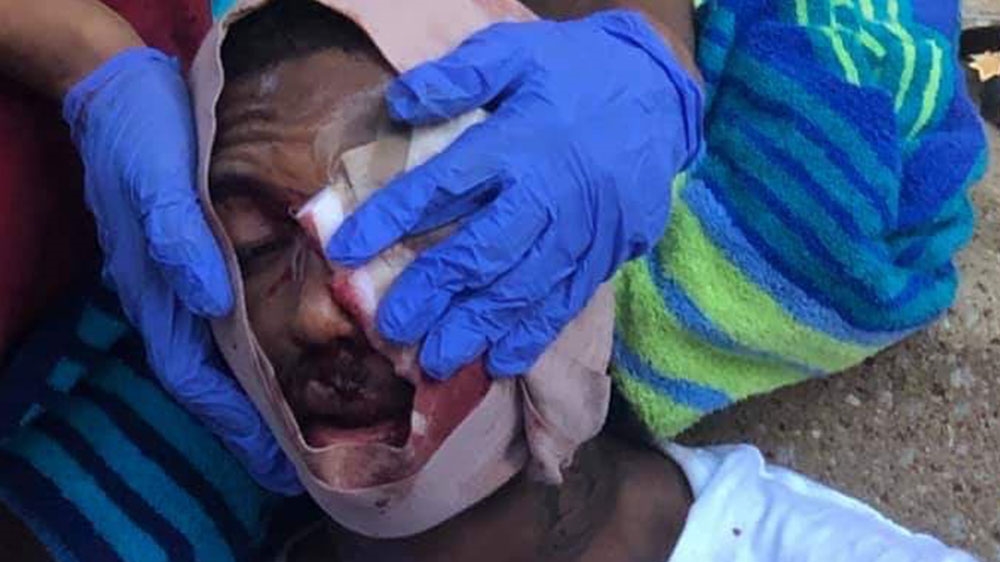
Saenz’s lawyer, Jasmine Crockett, said police did not attempt to get medical attention for the young Black man, and initially, “there was an issue with them [law enforcement] actually allowing an ambulance in” to attend to Saenz. Eventually, an ambulance rushed Saenz to the hospital, where he was told he had lost his left eye, seven teeth and would have to undergo multiple surgeries to repair facial fractures to the left side of his face. He was released from the hospital on his 26th birthday.
Volleys of tear gas, rubber bullets, pepper balls and other less-lethal weapons have been launched by law enforcement in the more than three weeks of protests that have gripped cities nationwide. Protests that started as outrage over recent police killings of Black people have since ballooned into wider demonstrations against the police violence used on protesters, with calls for the defunding of police departments nationwide.
The number of arrests at the demonstrations hit 10,000 on June 4, the Associated Press reported. Hundreds have been detained since, according to local media. Police have largely pointed to some incidents of violence, vandalism, looting and curfew violations as justification for their use of force. There were no curfews in place when both Saenz and Evans were hit. But protesters and experts alike said the increased militarisation of police forces and deep-seated institutional racism have created a situation where aggression is often law enforcement’s first response.
Police militarisation
Mike German, a fellow at Brennan Center for Justice and a former FBI special agent, said he is not all that surprised by the images of police force against Black Lives Matter protesters in recent weeks.
“I’m not surprised because we’ve seen that increasing militarisation of law enforcement and the increasing polarisation of society at large, but particularly separating police from the communities that they serve,” German told Al Jazeera, adding that there is this idea in law enforcement that “any criticism of police is unjustified and requires an aggressive response.”
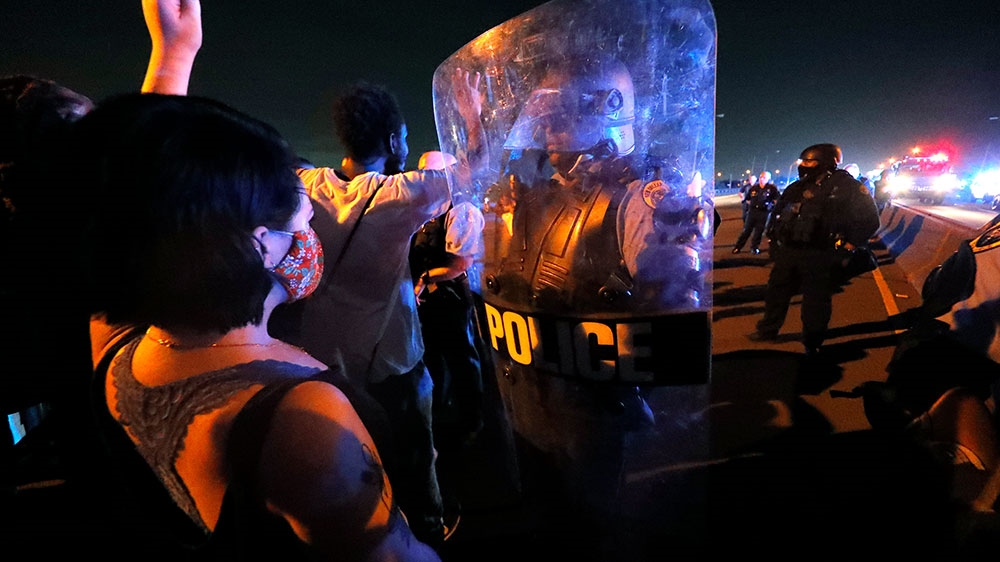
The militarisation of US police largely dates back to the 1990s with the inception of the 1033 Program or Law Enforcement Support Office programme, which allows police departments, regardless of size, to obtain surplus military equipment from the US Department of Defence. Since 1997, more than $7.4bn worth of property has been transferred to upwards of 8,000 law enforcement agencies spanning the country. This equipment includes mine-resistant vehicles, aeroplanes, helicopters, night-vision goggles, riot and tactical shields, rifles, office supplies, and other gear.
The military equipment at the disposal of US police departments was put on nationwide display during the 2014 unrest in Ferguson, Missouri after the fatal police shooting of Michael Brown, an unarmed 18-year-old Black man.
Part of the process of militarisation is to dehumanise both the forces and the target groups.
Following outrage at the use of military equipment in the city of 20,000, then-President Barack Obama, limited the scope of the 1033 Program. But in his first year in office, President Donald Trump signed an executive order reversing the Obama-era restrictions.
The equipment, training and part of the general process of “militarisation is to dehumanise both the forces and the target groups,” German explained. “So, it’s no longer, ‘if this person is doing something wrong and I, as an individual, I do my duty to arrest them’,” he added, but rather the militarisation creates a scenario of one group against the other.
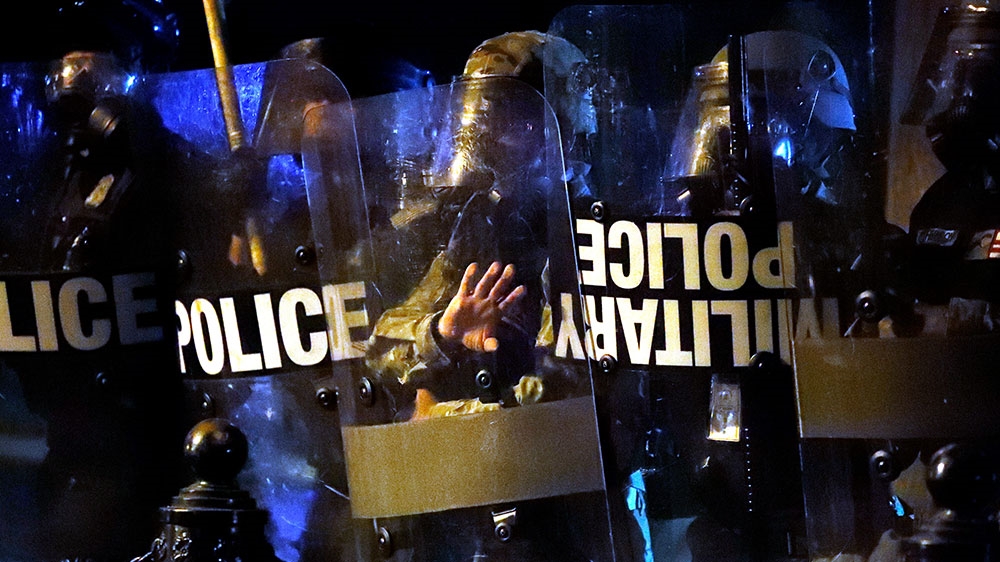
German said that this has played out in cities across the country during the recent anti-racism protests. In Buffalo, New York, two police officers shoved a 75-year-old man who fell and reportedly suffered a fractured skull. The two officers were initially suspended, prompting 57 of their fellow officers to resign from the force’s emergency unit. The two involved were later charged with assault. They have pleaded not guilty.
Two Buffalo policemen are charged with second-degree assault after they were filmed pushing a 75-year old protester to the ground, seriously injuring him. pic.twitter.com/0AyGMTxKSS
— Al Jazeera English (@AJEnglish) June 7, 2020
Julia Dupuis, an activist and writer, who was protesting on June 2 in Los Angeles, California when she was arrested by police, said the demonstrations have “felt like a warzone, like a battlefield” on the part of police.
“From the beginning, I think we’ve seen some pretty intensive police tactics, that kind of border on military tactics, you know, militarised equipment, like armoured vehicles, rubber bullets, tear gas, pepper spray,” Dupuis told Al Jazeera.
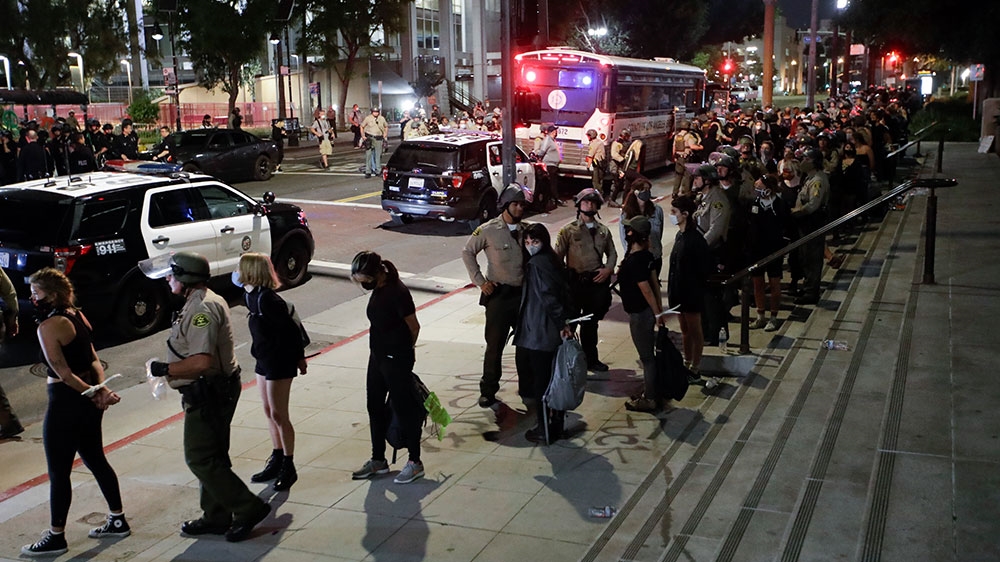
On the night of June 2, after a curfew went into effect, police – some dressed in riot gear – eventually trapped protesters on a street, Dupuis said. Members of the group decided to remain calm, she added, and not run to “try to minimise the brutality as much as we could”.
“We had seen and experienced the tear gas, the rubber bullets, and the really vicious arrests where they chase people down and beat them with batons before arresting them, and we didn’t want that to happen,” she said. About 30 “tense” minutes passed before police moved in and started arresting people, including Dupuis, who identifies as a gender non-conforming woman. She was placed in tight zip ties, and two male police officers began patting her down, including touching her breasts and calling her “it”, Dupuis said. She was then placed on a bus and driven more than an hour away.
we were protesting peacefully as the cops had hands on weapons and then arrested all several hundred of us #clownbus77 we made it https://t.co/OerOOTnkhh
— molly (@mollyliebman) June 4, 2020
Protesters were kept on the cramped bus, despite concerns over the novel coronavirus, for several hours, repeatedly denied requests to use the bathroom or loosen the zip ties, and mocked by police, she said, adding that they were eventually released after being given citations. Dupuis said her citation was later dropped.
Police ‘set the tone’
The mere presence of military and tactical gear, German said, inspires in law enforcement a certain mentality that often prompts aggression. “When you bring that [military] mentality and that training into law enforcement, that is by its nature, policing its own community, that leads to problems that would not otherwise exist,” German added. “It’s a matter of using anything uniform in the tools as a way to separate yourself from your society, that you’re policing.”
Protesters in several cities told Al Jazeera they felt it was often the police who set the tone.
Jason Rosenberg joined a march in New York City on June 2 to draw attention to police violence against the LGBTQ community, including the police killing of Tony McDade, a transgender Black man, in Tallahassee, Florida. Rosenberg and others marched in different places throughout the city, including Stonewall, the site of the 1969 uprising by the LGBTQ community after a police raid on a gay bar.
As the night drew on, and with a curfew in effect, Rosenberg said he began to see heightened escalation by New York City Police Department (NYPD) officers and arrests started to take place. At one point, protesters, Rosenberg said, formed a small arm-to-arm chain blockade of the police. That is when law enforcement moved in, the ACT UP NY member recalled.
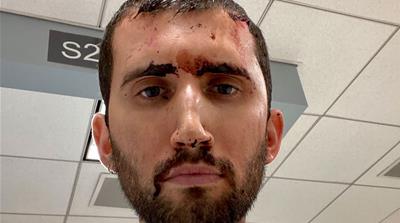
“Very quickly, they started beating us. We were not resisting arrest at all, but they continued to charge and hit and punch us,” he said.
Rosenberg believes he was knocked out before being placed in zip-tie handcuffs and realising a pool of blood had formed around his head. He said he was repeatedly denied medical attention, only receiving “cosmetic” aid when a nurse wiped blood off his head once they arrived at the police precinct. After being released and given a summons, Rosenberg went to the hospital and learned he had suffered a fracture to his arm and received 11 staples to close a wound on his bloodied head.
“I definitely think the appearance [of police in riot gear] really sets the tone for protests,” Rosenberg said. “Even the night before where there was a curfew … we weren’t really met with riot gear that night, and it was a very tame and quiet protest. And so, I think the police always set the tone for how the night or a protest is going to end up.”
The threat of violence is a form of violence itself.
Steven Thrasher, a Northwestern University assistant professor and journalist who has covered protests for years, agrees, but added that it is not just the military gear, but often the very act of policing.
“The threat of violence is a form of violence itself,” Thrasher said. “The police are always threatening, threatening to potentially harm us. And so, that itself is a form of violence. And it’s come out very obvious in ugly ways in the past few months.”
Curfews ‘used as weapons’
Thrasher said that this has been particularly apparent in protests against police violence this time around and in years past, especially when curfews have been imposed. Although most curfews have been lifted in cities across the US, mayors were quick to implement them and call in the National Guard after the initial protests in an effort, they said, to quell some of the unrest, including vandalism, looting and fires, that had been seen after dark.
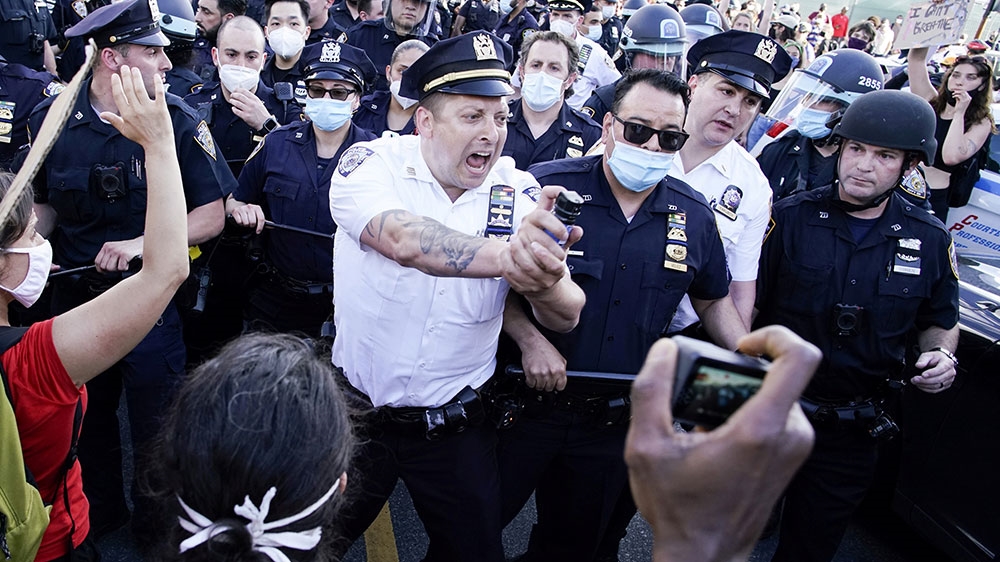
While Thrasher said that curfews are not a justification for violence, he believes law enforcement see them that way. “They make everyone a criminal, and the curfew means everyone is breaking the law,” he said. “It creates the mechanism by which these encounters [between police and protesters] happen, which of course can quickly become violent.”
Allison Lane, a podcaster and president of the newly formed Bartenders Against Racism group in Washington, DC, said she did not intend on staying out past the city’s 7pm curfew on June 1. But when police started pushing peaceful protesters back outside the White House with pepper balls and flashbangs, she was redirected to an area where demonstrators continued to rally peacefully past curfew, unaware at the time that the sudden force used outside the president’s residence was to clear the way for a Trump photo opportunity.
I’m at a house in DC after being pepper sprayed and knocked down by the police. There are about 100 of us in a house surrounded by cops. All the neighbors on this street opened their doors and are tending to protesters. The cops corralled us on this street and sprayed us down.
— Allison Lane (@allieblablah) June 2, 2020
Lane, along with a group of more than 100 others, continued marching, eventually being pushed by police onto the residential Swann Street. It was not long before police started shoving and tear-gassing the group, Lane said, forcing dozens to flee into the home of a resident who had opened his doors to protesters. The group inside the home watched as police arrested several people on the street. Lane live-tweeted the action from the house for much of the night. Police arrested nearly 200 people in total. Those inside stayed until sunrise – when the curfew ended. Lane feels the curfews have been used as a sort of weapon against protesters.
“I felt like regardless I’m going to be out there,” she told Al Jazeera, adding that she is “scared as a Black woman … [and] somebody who’s not in a position of power.”
But, she said, “having the right to protest is very sacred.”
‘Wake up call’
Some police departments and city officials have taken action against officers who have used what has been deemed excessive force against protesters and those breaking curfew. In Atlanta, Georgia, prosecutors charged six police officers with “using excessive force” against two college students who had been caught in traffic post-curfew when the law enforcement officials broke the windows of their car, pulled them out of the vehicle and tased the driver. Four of the officers involved have also been fired. A judge in Seattle, Washington, banned police from using chemical irritants, such as pepper spray and pepper bullets on protesters through September. Officials in other cities have called for similar bans.
But police have also defended their actions, saying the use of tear gas, rubber bullets and other less-lethal weapons is necessary to disperse large crowds and control protesters who have become violent.
“If we pull back, we’re giving up downtown, we give them that space. But once we give them that space, we cannot control what happens in that space. … We would have been one of those cities on the news burning,” said San Jose, California, police department Captain Jason Dwyer, while defending his officers’ actions during protests earlier this month, local media reported.
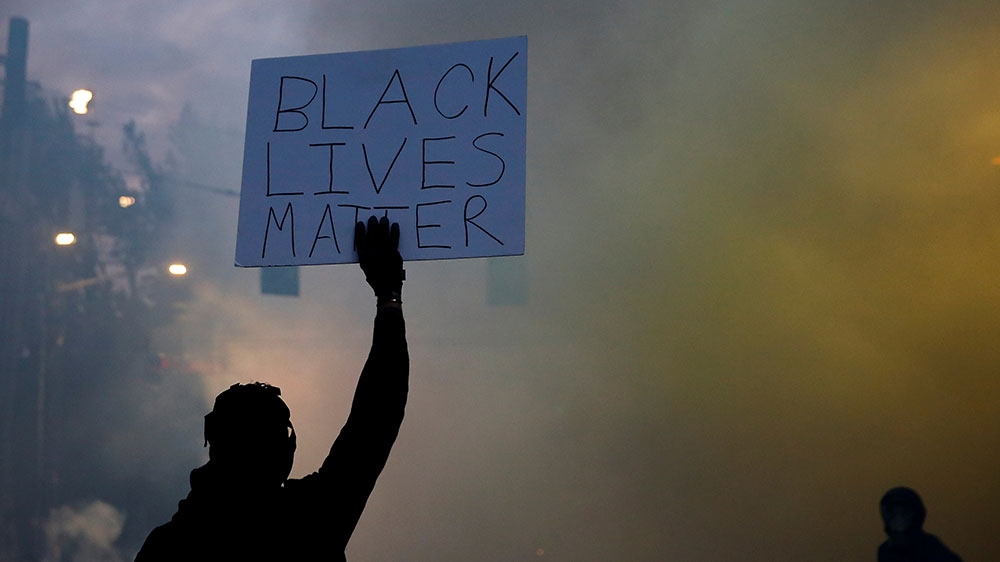
In the case of Los Angeles activist Dupuis, a police commander reached out to her on Twitter, saying he would like a “complaint taken on her behalf”. She has not responded, saying that while she appreciates that the department reached out, she does not trust the “corrupt system” to investigate its own people. As of June 10, LAPD said it had received 56 complaints related to the protests, including 26 alleging use of force by police. At least 10 officers have reportedly been placed on desk duty pending investigations. The LAPD police chief has previously reportedly said the department was reviewing its response to the protest, including the transfer of arrested protesters in crowded buses. The LAPD did not respond to Al Jazeera’s request for comment.
New York City’s Civilian Complaint Review Board, an independent agency, has received hundreds of complaints related to the NYPD response to protesters. At least one officer has been charged for shoving a woman at a protest. New York Attorney General Letitia James has held two days of public hearings to gather testimony from protesters. She said in a statement last month that her office will “act independently to seek answers, ensure that the truth is laid bare, and that there is accountability for any wrongdoing”.
The Metropolitan Police Department (MPD) police chief in Washington, DC defended law enforcement actions in the incident on Swann Street, saying in a news conference in early June that there was no evidence that anyone had been “decimated or beaten” by police, but that the Internal Affairs Bureau would investigate to ensure all arrests were appropriate. MPD confirmed that the probe is ongoing.
In Dallas, Texas, the police department’s public integrity department is investigating Saenz’s case, Dallas Police Department Sergeant Warren Mitchell confirmed to Al Jazeera. “Rest assure, there is a full investigation being conducted and we will take whatever action deemed appropriate at the conclusion of the investigation,” Mitchell said via email.
Saenz and his legal team want the officer responsible for using the less-lethal weapon that resulted in the young man losing an eye to be held accountable. Dallas police also agreed to cease the use of tear gas and other less-lethal police crowd-control weapons, including rubber bullets, against protesters through early September.
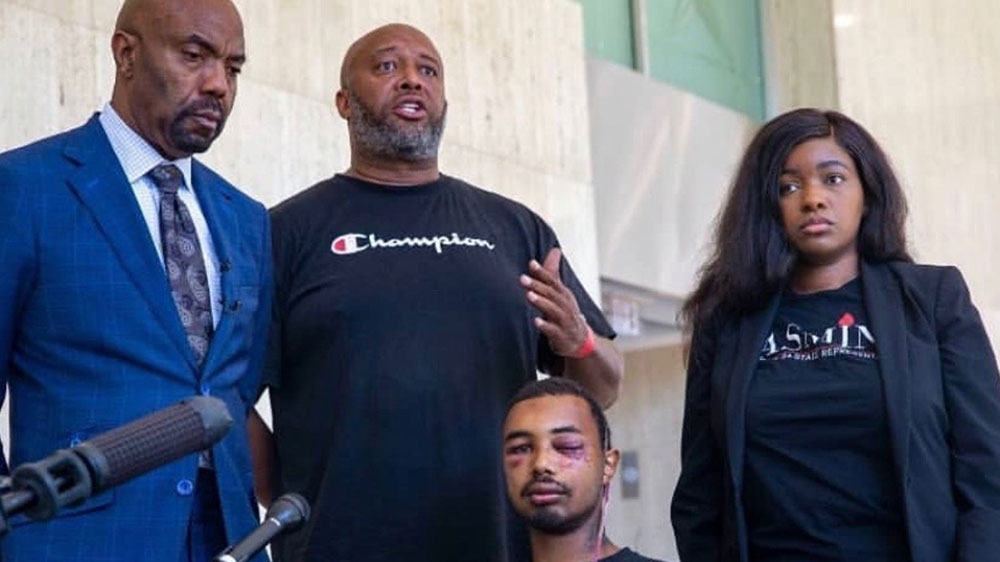
Austin native Evans said police have interviewed him and said there is video of the incident in which he was shot in the face. Austin police officials directed Al Jazeera to a June 1 Facebook live by Chief Brian Manely, who said the department is investigating all incidents in which protesters were injured. The department did not answer specific questions about Evans’s case. Manley said during an Austin City Council Public Safety Committee meeting on Thursday that the department has ended its use of “less-lethal shotgun” in crowd situations. City officials said they have submitted 255 complaints against police officers for investigation.
Anthony Evans suffered a fractured jaw after being shot by Austin PD in the face with “less-lethal” ammunition. He is now recovering with his family in Buda and has a long recovery ahead of him. You can support his medical fund below: https://t.co/F5SNw1NvGx
— Erin Zwiener (@ErinForYall) June 5, 2020
Most of the protesters who spoke to Al Jazeera said that while their injuries may physically prevent them from going back out onto the streets, they remained undeterred in their efforts to bring justice to the victims of police violence. Many called for the defunding of police and investment in minority communities across the country.
The Brennan Center’s German added that while there may be “good, well-intended officers”, unless authorities recognise and “address that there is explicit bias and racism in law enforcement” then even seemingly meaningful reforms and training will not help. “We have to acknowledge that this is a real thing and that it needs to be rooted out.”
Back in Texas, both Evans and Saenz said they are grateful for the outpouring of support for those in the community and elsewhere, including thousands of dollars raised on each of their respective gofundme pages.
Evans says he is focused on getting better and doing what he can do to help the next person and “educate them and just bring awareness to the harms that come with fighting for the cause”.
“Some people think it’s just people out there rioting who are getting hurt, and they say, ‘they kind of deserve that’, but [with me], you get to see firsthand, someone that was spreading love,” he said. “It’s almost like an eye-opener .. we’re all in this together.”